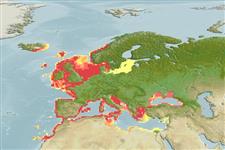Environment: milieu / climate zone / depth range / distribution range
Écologie
marin démersal; profondeur 1 - 150 m (Ref. 6790), usually 1 - 30 m (Ref. 35388). Temperate; 66°N - 27°N, 19°W - 42°E
Eastern Atlantic: Norway to Morocco, Madeira and Canary Islands, including the Mediterranean and the Black Sea (Ref. 6790). Reported from Mauritania (Ref. 55783).
Length at first maturity / Taille / Poids / Âge
Maturity: Lm 12.0 range ? - ? cm
Max length : 53.0 cm TL mâle / non sexé; (Ref. 40637); common length : 25.0 cm SL mâle / non sexé; (Ref. 3397); poids max. publié: 1.9 kg (Ref. 40637)
Body elongate, length more than 6 times height. Greenish in upper parts, yellowish-white oblique stripes. Small 2-3 spines in front of each eye (Ref. 35388).
On sandy, muddy or gravelly bottoms, from a few meters to about 150 m. Rest on the bottom, often buried with eyes and tip of first dorsal fin exposed (Ref. 9988). At night they swim around freely, even pelagically (Ref. 35388). Feed on small invertebrates and fishes; chiefly nocturnal. Oviparous, eggs and larval stages pelagic (Ref. 4675). There are dark markings along the scales; the anterior dorsal fin is black and contains venomous spines. Utilized fresh and frozen; can be pan-fried, broiled, boiled and baked (Ref. 9988). Spawning takes place in June and August, pelagic eggs are 1 mm (Ref. 35388). Also Ref. 57406.
Oviparous, eggs and larvae are pelagic (Ref. 4675).
Roux, C., 1990. Trachinidae. p. 893-895. In J.C. Quero, J.C. Hureau, C. Karrer, A. Post and L. Saldanha (eds.) Check-list of the fishes of the eastern tropical Atlantic (CLOFETA). JNICT, Lisbon; SEI, Paris; and UNESCO, Paris. Vol. 2. (Ref. 6790)
Statut dans la liste rouge de l'IUCN (Ref. 130435)
Utilisations par l'homme
Pêcheries: intérêt commercial mineur; pêche sportive: oui; Aquarium: Aquariums publics
Outils
Articles particuliers
Télécharger en XML
Sources Internet
Estimates based on models
Preferred temperature (Ref.
123201): 8.7 - 18.7, mean 10.9 °C (based on 780 cells).
Phylogenetic diversity index (Ref.
82804): PD
50 = 0.5059 [Uniqueness, from 0.5 = low to 2.0 = high].
Bayesian length-weight: a=0.00562 (0.00458 - 0.00691), b=3.05 (2.99 - 3.11), in cm total length, based on LWR estimates for this species (Ref.
93245).
Niveau trophique (Ref.
69278): 4.2 ±0.71 se; based on food items.
Résilience (Ref.
120179): Milieu, temps minimum de doublement de population : 1,4 à 4,4 années (Assuming tm=2-4).
Fishing Vulnerability (Ref.
59153): Moderate to high vulnerability (52 of 100).
Climate Vulnerability (Ref.
125649): Moderate vulnerability (38 of 100).
Nutrients (Ref.
124155): Calcium = 29.9 [20.3, 57.9] mg/100g; Iron = 0.36 [0.23, 0.58] mg/100g; Protein = 18.7 [17.9, 19.4] %; Omega3 = 0.643 [0.399, 1.025] g/100g; Selenium = 13.2 [7.3, 25.9] μg/100g; VitaminA = 23.8 [7.7, 74.1] μg/100g; Zinc = 0.445 [0.328, 0.607] mg/100g (wet weight); based on
nutrient studies.
